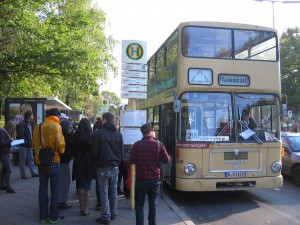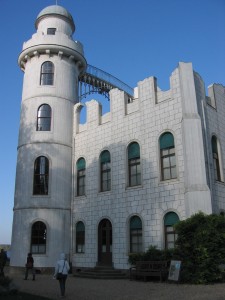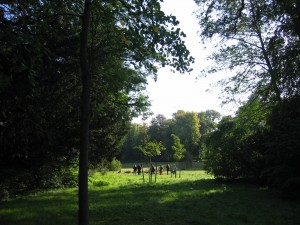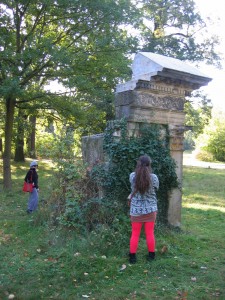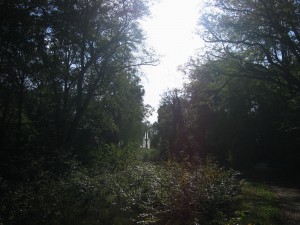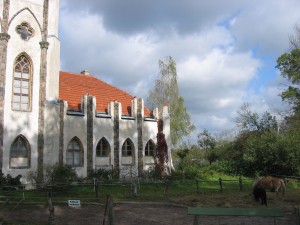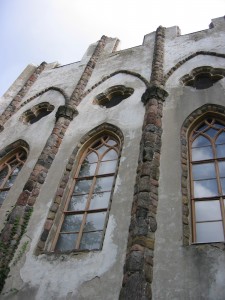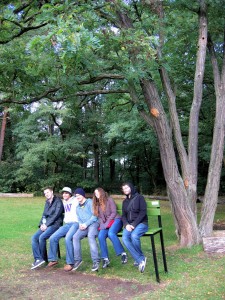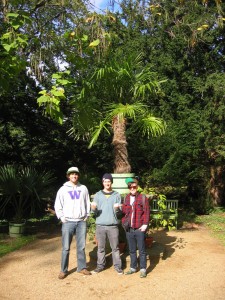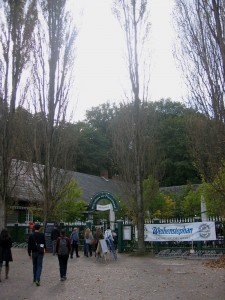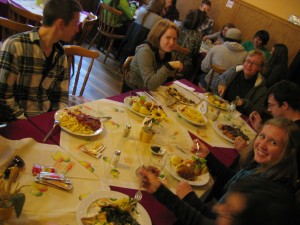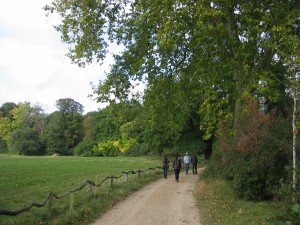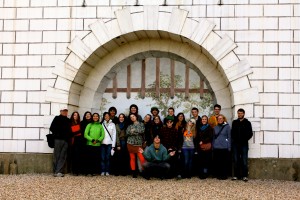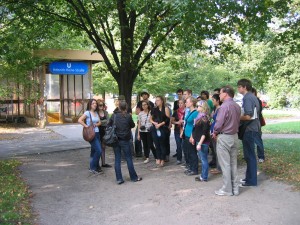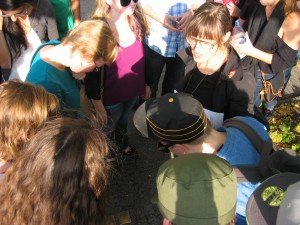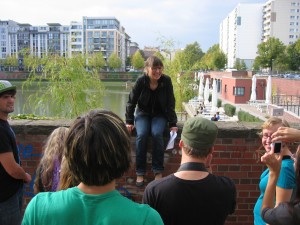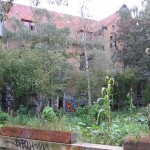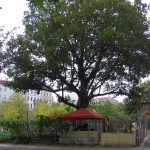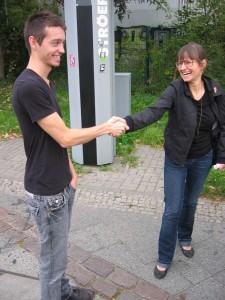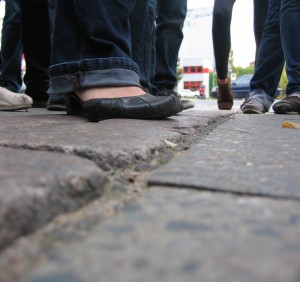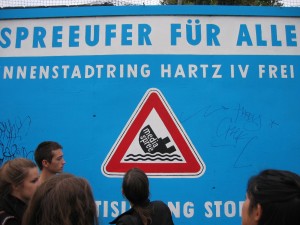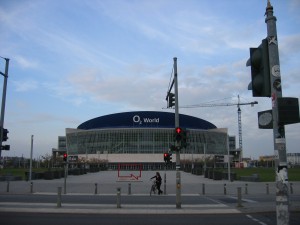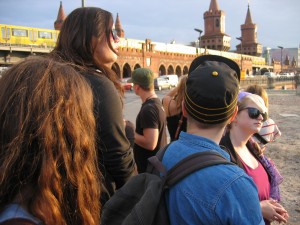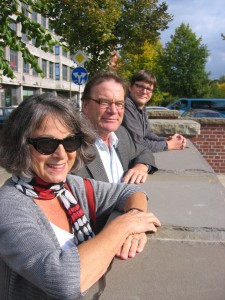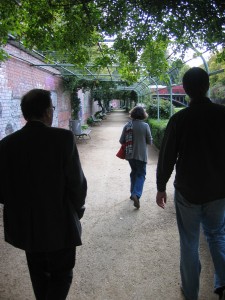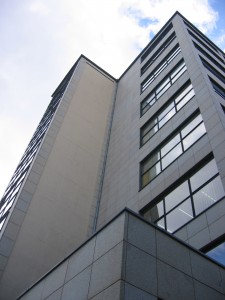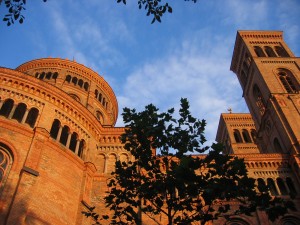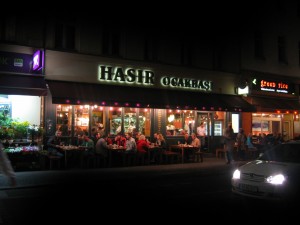A day on the Pfaueninsel
On Friday we took a trip about an hour outside of Berlin to a magical place called the Pfaueninsel – Peacock Island – for a class retreat. Our goal wasn’t to engage with official historical narratives so much as to relax and be together in a beautiful natural setting!
After riding the S-Bahn to Wannsee, we got to ride on a classic double-decker bus that took us through the woods to the entrance to the island.
Our first stop on the island was Schloss Pfaueninsel, erected for King Friedrich Wilhelm II and his mistress Wilhelmine Enke in the 1790s. Built from wood, it’s supposed to look like a white ruin on the island of Capri!
Of course, the first thing everyone looked for on the island were the eponymous peacocks – and the students found, and were chased aggressively by – a whole flock of them!
The island contains no end of sublime vistas and interesting architectural follies. It was formerly one of the many pleasure grounds of the Prussian royalty, replete with ridiculous attempts at the picturesque. For instance:
A “dairy” in the form of ruined Gothic church, where the king and his mistress could first play at milking the cows before going upstairs to drink milkshakes in an ornately decorated salon!
The island has some quirky modern works, too …
… and there are allusions to buildings that are no longer there, as well. A palm house designed by Karl Friedrich Schinkel once stood on this site, but it burned down in the late 19th century. A pleasant little palm garden pays homage to the absent building.
Though it was sunny, the weather was quite cold and windy. By lunchtime, we were thankful to sit down in the cozy Wirtshaus zur Pfaueninsel and enjoy some delicious home-style German food. Schnitzel, wild boar, Klopse (meatballs), Flammkuchen and pumpkin soup were all on the menu, accompanied, of course, by generous helpings of potatoes!
As we headed home, I couldn’t help thinking about the royals who had once frequented the island. What were their lives like? How would they have experienced the space? We’ll be finding out more about how they lived this coming week, when we visit Park Sanssouci, home to several royal Prussian palaces.
A walk through our Kiez with Manuela Mangold
Manuela Mangold, a long-time Kreuzberger, gave us a fantastic tour of the students’ “Kiez” in Berlin on Tuesday afternoon. Kiez is a local word meaning “neighborhood,” but it denotes not just a district of the city (in this case, Kreuzberg), but one’s immediate, local surroundings — the place where everyday life is lived.
We started our tour at the Heinrich-Heine-Strasse U-Bahn station, the stop where the students regularly get onto the subway. During the time when Berlin was divided, it was a border crossing used mainly for commercial traffic. Below, the subway station was a “ghost station” — because the wall ran in a zig-zag manner from roughly the southeast to the northwest, trains going from this part of West Berlin would pass under East Berlin on their way to other parts of West Berlin would pass through a completely darkened (and sometimes guarded) station.
Next on our tour was an example of Stolpersteine (“Stumble Stones”), an art project begun in Cologne, but which has left its mark all over Berlin. A form of Holocaust memorial, it marks where victims of the tragedy once lived. People are meant to “stumble” over these on their daily walks, a constant reminder of the importance of remembering the Holocaust, and its impact on life here.
We continued with a look at the path of the Berlin Wall and death strip. Manuela is sitting right between former East and West in the picture! As in most of Berlin, it’s been restored so nicely now that barely a trace of the division remains.
Oppositional culture has been a huge part of Kreuzberg’s identity since the 1970s. Here are two examples of “squatter” culture — both built right up against the Wall. One is a famous house squat, and the other a garden built right in the shadow of the wall, in what was technically East German territory!
We continued along the path of the wall, which is (in some places) marked by a strip of brick set into the ground. (Dominic represented East Germany, shaking hands with a West Berliner!)
Leaving our Kiez and crossing the Spree River, we continued on to talk about the politics of development along the river banks, another area where squatters and other oppositional movements have traditionally made their homes. Now big developers are buying up large swaths of property, driving up rents and bringing a whole new feel to the neighborhood, garnering vehement protest from locals. One glaring example of this is O2 World, a large concert venue whose undeniably corporate aura conflicts tangibly with its surroundings. Its VIP entrance along the river was heavily protested, but got built anyway.
We ended our tour at the Oberbaumbrücke, which was also divided by the Wall. Now, as you can see in the background, the U1 train line can run all the way across it again!
Our Kiez is in some ways the perfect spot for the students, sitting uncomfortably amidst the former East and West, scarred with layers of memory and history – and still transforming before our eyes.
warming up to Berlin
Chance and I met John and his lovely wife Eleanor today in their (and the students’) new Berlin neighborhood, Kreuzberg. It’s a beautiful part of the city, with a lively and diverse feel. Though we spent most of the day taking care of various administrative and technological tasks (it’s always a challenge to get settled into a whole new system of cell phones, internet and ATMs!), we got to enjoy the great fall weather and explore a little of our new surroundings too.
We started out with a walk through the park along the Engelbecken and Luisenstadt Canal.
Like the rest of Berlin, the architecture in this neighborhood is full of contrasts. We admired the Max-Taut-Haus on Oranienplatz, which fits so well into Berlin’s current aesthetic that you might never guess it was built between 1931-33. Max Taut, the architect, was Bruno Taut’s brother. The stately St. Thomas Kirche was constructed in the mid-1860s.
We finished up the evening at Hasir, a delicious Turkish restaurant on the corner of Orianienstrasse and Adalbertstrasse.
The students arrive on Monday, and we’re looking forward to commencing our explorations of this fantastic neighborhood – and the rest of the city – together!
tags
the author
I'm a doctoral student at CUNY Graduate Center. I'm thrilled to be teaching the CHID Berlin program with Prof. John Toews! You can contact me at naraelle [at] gmail.com, or find out more about me at www.naraelle.net.
Blogroll
- Annie Holden's blog
- Cassie Hoeprich's blog
- Dominic Barrera's blog
- Janet Williams's blog
- Mariah Alderete's blog
- Melissa Au's blog
- Robert Hampton's blog
- UW Students Study Abroad Our students Natalie and Cassie are contributing to the official IPE student blog this fall!



